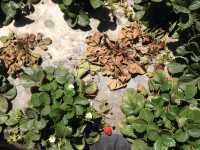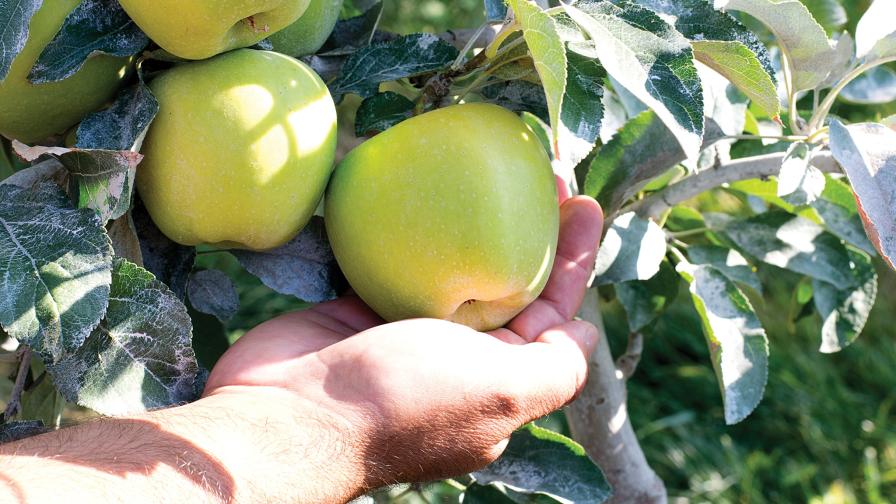Understand The Viral Disease Pallidosis-Related Decline In Strawberries

Greenhouse whitefly is the predominant species of whiteflies on strawberries in California’s Central Coast. What used to be a pest causing yield loss through direct damage has now emerged as a vector of a devastating viral disease called pallidosis-related decline of strawberries.
Some fields in Santa Maria and other areas that suffered from heavy whitefly infestations early in the season later developed symptoms of pallidosis-related decline.
Diagnostic tests conducted by California Department of Food & Agriculture and USDA laboratories in Salinas and Corvallis, OR, identified multiple viruses that cause the decline in some samples.
Proper diagnosis is important in determining the disease, but many fields showing pallidosis-like symptoms may not have been tested. Extent of infection varied from mild disease symptoms in some fields to total dieback, depending on the partner viruses and the cultivars.
Corresponding yield loss also varied, registering up to 65% reduction in some fields according to growers’ estimates. Based on the feedback received from various sources, pallidosis-like symptoms are seen in strawberry cultivars from both public and private breeding programs.
Pallidosis-Related Decline
This is a viral disease caused by a complex of viruses transmitted by whiteflies, aphids, pollen, nematode, seed, fungus, and unknown sources. Disease occurs only when one of the whitefly transmitted viruses along with one of the other viruses is present in the plant.
Actual mechanism of infection and the synergistic interaction between the virus partners is not clearly known, but symptoms vary depending on the type of virus present. Whitefly-transmitted viruses include beet pseudo-yellows and strawberry pallidosis associated viruses.
Numerous viruses, however, are not transferred by whiteflies. For example, Strawberrry mild yellow edge virus is transmitted by aphids; strawberry necrotic shock virus by thrips, pollen, and seeds; and Strawberry latent ringspot virus by nematodes and seeds.
Pallidosis disease is indigenous to North America which was first described by researchers in 1969 and first reported in California in 1975. Pallidosis virus could be latent in production fields and generally does not produce severe symptoms without the synergistic interaction with other viruses.
Disease Symptoms
Symptoms include stunted plant growth, purple or red coloration especially of older leaves, and brittle roots. When infection progresses, leaves dry out, and plants eventually die. Newly emerged leaves may not show infection symptoms due to the seasonal fluctuations of virus titers, but the virus is systemic and remains in the infected plants. When pollen-borne virus is involved, plants may recover from the symptoms of infection.
Since several recent strawberry cultivars have general tolerance to viruses, symptoms may not be visible when single virus or some combinations of viruses are present. The extent of disease symptoms from pallidosis-related decline also varies depending on strawberry cultivars and the combination of partner viruses. ELISA (Enzyme-Linked Immuno-Sorbent Assay) or PCR (Polymerase chain reaction) techniques are generally necessary to detect the causal organisms in infected plants.
Routine testing would not detect pallidosis disease causing viruses. Since symptoms of several plant diseases and disorders could be similar, proper diagnosis is important to determine the disease.
In 2011, there was a field that had plants dying from an unknown cause. Symptoms look similar to what we are seeing now in plants suffering from pallidosis disease. Not suspecting pallidosis disease, those plants in 2011 were not tested for virus.
In general, nematodes are controlled by fumigation and are not a pest in strawberries. Various species of aphids occur at low numbers in California strawberry fields and usually do not require targeted treatments. Thrips are also routinely seen in strawberry fields and are effectively treated. However, increased whitefly infestations on newly planted strawberries coupled with aphids and pollen transmitted by multiple partner viruses probably contributed to this new problem.
Management Options
To manage a problem such as pallidosis-related decline vectored by widespread pest like whiteflies, a multi-disciplinary approach with the partnership of multiple agencies is required. With overlapping seasons of fall and summer plantings extended by second year production and the presence of other hosts, whiteflies may continue to be present throughout the year, posing an increased risk. Efforts are needed to break the pest cycle and minimize the disease risk.
It is important to note that there are no chemicals to treat pallidosis disease. To help reduce disease incidence, growers are advised to:
- Use disease-free transplants to prevent the introduction of one or more partner viruses. Additional virus screening may be needed to test for more viruses.
- Manage whitefly, aphid, and other vectors to reduce disease spread.
- Avoid planting near infected fields.
To manage whiteflies and aphids, it is important to pay attention to them on nearby hosts or second year berry fields especially those upwind before they move to newly planted or other fields. Second year berry fields can be a good source of infestation for the new fields. Pruning them close and discarding the debris is important in reducing the pest pressure.
Other steps include conserving natural enemies and watering roadways to prevent dusty conditions, promoting natural enemies.
Insect Controls
Fortunately growers have many chemical options. For whiteflies, use lower volume of spray fluid than usual, pass the sprayer more slowly, and ensure thorough coverage of the lower side of the foliage. Be sure to rotate using different modes of action.
Chemicals impacting the nervous system: Imidacloprid (Admire Pro), thiamethoxam (Actara), and acetamiprid (Assail).
Sodium channel modulators: Fen-propathrin (Danitol) and pyrethroids
Acetylcholinesterase inhibitors/organophosphates: Diazinon and malathion.
Insect growth regulators: Pyriproxyfen (Esteem).
Oils and soaps: Narrow range oil (Omni Oil) and insecticidal soap (M-Pede).
Botanical and microbial pesticides also can be used. In the botanical category, Azadirachtin, a neem-based insect growth regulator can be used on immature stages.
In addition, microbial pesticides, including insect pathogenic fungi such as Beauveria bassiana, and Isaria fumosorosea, can be used against whiteflies and aphids.
Here is a video on pallidosis disease: www.youtube.com/watch?v=m1YRRE_PY8s










